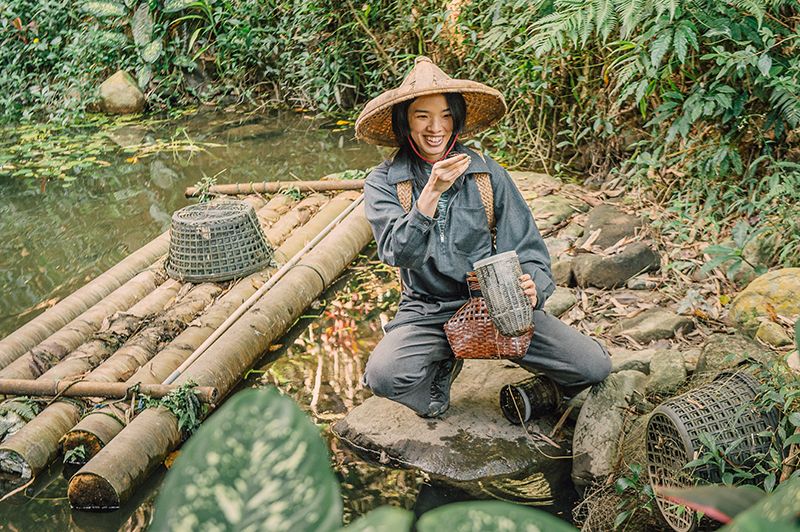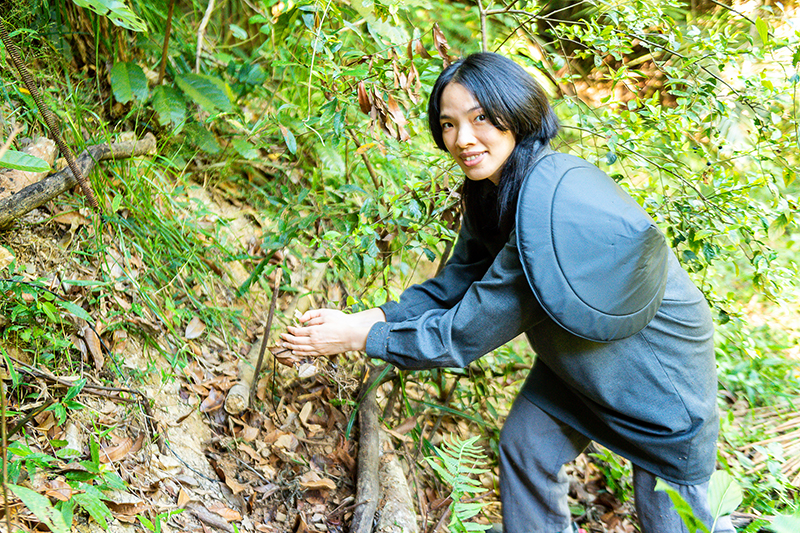You have visited other Bunun communities before, how is this one different from the others?

The Bunun communities I visited before also have a lot of vegetable gardens, but theirs don’t blend into the surroundings as well. Most of them are flat gardens tended by the elderly and surrounded by mountains. They are also very vast. The gardens I saw today are terraced fields in the woods.
The mentors introduced a lot of plant knowledge today, thoughts?

Many of those plants can also be found in the plains and we have a vague idea of how to use them, but the mentors know more in-depth details. For example, we were all taught that Giant Elephant’s Ear is poisonous, don’t touch it. But today the mentors said that Giant Elephant’s Ear can heal hornet stings. This is wilderness experience and knowledge directly from nature, not from other people. My Bunun friends have even more rare knowledge about the mountain wilderness. They can identify plants that I have never seen before, let alone know what they are.
I usually don’t pay attention to my surroundings when I’m in a natural environment, but after today, the plants suddenly start to stand out. Right off the top of their heads, the mentors shared how to eat the plants and how to use them. When I taught drawing lessons to Bunun students, I’d ask them to draw their gardens or animals that they’ve seen or unforgettable stories. But maybe these are too common for them, so they don’t really elaborate on them.
As for us Non-indigenous people, we don’t really use plants enough. Most of us just admire the flowers at the flower markets, that’s all. My mother grew up in the Hakka rural area, so she knows a lot about plants, too. But I just can’t remember anything about plants, so my Mom is always like, “how can you not even know this?” But I do enjoy drawing plants. When I visited Wu Sheng’s (Taiwanese author) tree garden to collect inspiration, he also introduced a lot of indigenous species to me.

You visited the mentor's home village today to learn more about the mountains and forests. Do you have any past experience going into the mountains?
 The mountains I visited are more like recreational destinations, like Elephant Mountain, Tiger Mountain, Qixing Mountain, Jiufen, and Jinguashi. When I’m in the mountains, I just calmly walk and think, breathe in the phytoncide, and purify my soul and mind. I’m a homebody, I usually stay in Taipei and rarely go outside. When I do it’s usually because someone set up an assignment for me. For example, some of the indigenous friends I met recently want to rebuild their Atayal family house and hope that I can illustrate their execution process into a comic. I might need to go into the mountains with them early next year. That would be the first time I’ve gone so deep into the forests. The indigenous peoples I’ve interacted with so far have all relocated to the foot of the mountains.
The mountains I visited are more like recreational destinations, like Elephant Mountain, Tiger Mountain, Qixing Mountain, Jiufen, and Jinguashi. When I’m in the mountains, I just calmly walk and think, breathe in the phytoncide, and purify my soul and mind. I’m a homebody, I usually stay in Taipei and rarely go outside. When I do it’s usually because someone set up an assignment for me. For example, some of the indigenous friends I met recently want to rebuild their Atayal family house and hope that I can illustrate their execution process into a comic. I might need to go into the mountains with them early next year. That would be the first time I’ve gone so deep into the forests. The indigenous peoples I’ve interacted with so far have all relocated to the foot of the mountains.
You learned how to make traps today, did you have any hunting experience when you visited the Bunun communities in the past? How was it?

The Bunun people I met before mostly do farm work, their ancestors were relocated to the plains during the Japanese Occupation Period to work in the fields. But they are also hunters. Nowadays they mainly work with the Forestry Bureau on conservation projects and also patrol the mountains to catch illegal loggers. So I haven’t participated in hunts that actually catch animals. I do know that they carry rifles with them when they go into the forests and may take action if needed, which is not the same as passively putting down traps like today. I’m surprised that you can make a trap with such simple tools. I’ve only seen snap traps before and I’ve never seen such a traditional handmade contraption.
This is the first time I’ve made these traps. I think shrimps are not very bright, they actually think the traps are their homes. It was very interesting today to experience the life of indigenous peoples. I can imagine them using these hunting tools in the past, just like how we go shopping in convenience stores: the mountain is their convenience store and they just make traps when they want to eat.

What are your thoughts on indigenous hunting traditions?

When I talk about the indigenous peoples with my friends, they would say things like, “their ethnic background lets them get extra points in exams”, or “they should stop hunting because the wild animals are almost gone”. However, if hunting is part of their tradition and they don’t do it like in Africa where the rich pay to hunt giraffes on jeeps, I don’t believe we need to forbid it. The indigenous people just want to make a living. Humans are also part of nature, although some environtologists exclude humans and some include us. It’s all very academic so I don’t recall it clearly, but if humans are included, then I think the indigenous peoples are the closest to nature. And if we want to push it further, in the past the Non-indigenous people viewed the indigenous people as animals, not humans. If you view indigenous peoples like that, then hunting is part of their nature, you can’t just change your mind now and say “you are now considered human and you cannot hunt”.
When the western law system was introduced to Taiwan, there were conflicts between the system and local culture. But when the ruling party wants to exclude certain groups from the regulations, there will be problems. Taiwan has customary laws, so some bad Non-indigenous customs, such as foot binding, are gone. Of course, there were other customs that just disappeared without concrete reasons. But the traditional cultures of the indigenous peoples were preserved, why? Today I heard that it was because the missionaries helped preserve some of them, so the customary laws gave the indigenous peoples a little more flexibility than the Han people, but there wasn’t much elbow room, either, to be honest. Five years ago I met some legal consultants who were talking about using customary laws as a reference to revise national laws so that the public can accept them. But these processes take a lot of time.
What are your thoughts on the indigenous peoples cultural revitalization?

I know originally only a few Bunun groups sang the Pasibutbut, but now it has become mainstream for all Bunun people. It feels like all Bunun people are reviving Pasibutbut, but in reality, a lot of this culture is reconstructed. The Taiwan Plains Indigenous Peoples, maybe because they have fewer people, can only focus on reviving language and literature. When I heard about that I was curious, like, in addition to the modern poetry they wrote, are there any more ancient materials that exist? Like the Bunun would pass down some ancient songs or warrior songs that describe the people’s lives and culture. The Pazeh also have their own language, so I wonder if their ancestors also wrote things down to express their feelings?




